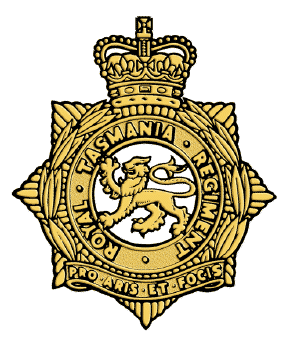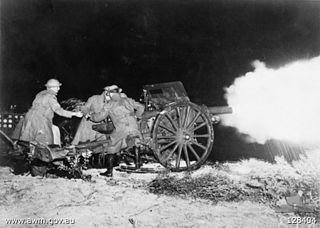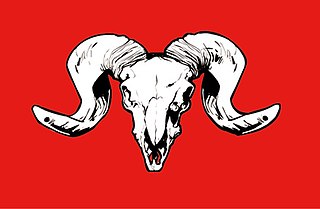
The Royal Regiment of Artillery, commonly referred to as the Royal Artillery (RA) and colloquially known as "The Gunners", is one of two regiments that make up the artillery arm of the British Army. The Royal Regiment of Artillery comprises thirteen Regular Army regiments, the King's Troop Royal Horse Artillery and five Army Reserve regiments.

The Australian Army Reserve is a collective name given to the reserve units of the Australian Army. Since the Federation of Australia in 1901, the reserve military force has been known by many names, including the Citizens Forces, the Citizen Military Forces, the Militia and, unofficially, the Australian Military Forces. In 1980, however, the current name—Australian Army Reserve—was officially adopted, and it now consists of a number of components based around the level of commitment and training obligation that its members are required to meet.

The Royal Regiment of New Zealand Artillery is the artillery regiment of the New Zealand Army. It is effectively a military administrative corps, and can comprise multiple component regiments. This nomenclature stems from its heritage as an offshoot of the British Army's Royal Artillery. In its current form it was founded in 1947 with the amalgamation of the regular and volunteer corps of artillery in New Zealand. In 1958 in recognition of services rendered it was given the title the Royal Regiment of New Zealand Artillery.

The Royal Regiment of Australian Artillery, normally referred to as the Royal Australian Artillery (RAA), is a Regiment of the Australian Army descended from the original colonial artillery units prior to Australia's federation. Australia's first guns were landed from HMS Sirius and a small earthen redoubt built, near the present-day Macquarie Place, to command the approaches to Sydney Cove. The deployment of these guns represents the origins of artillery in Australia. These and subsequent defences, as well as field guns, were operated by marines and the soldiers of infantry regiments stationed in Australia. Unlike their British and Canadian equivalents, there are no regiments of horse artillery in the order of battle of the Royal Australian Artillery. The First World War saw the raising of 60 field, 20 howitzer, and two siege batteries along with the heavy and medium trench mortar batteries. Until 19 September 1962 the Australian Artillery was referred to as the 'Royal Australian Artillery', however, on this date Queen Elizabeth II granted the RAA the title of 'The Royal Regiment of Australian Artillery'. The Regiment today consists of Regular and Reserve units.

104 Regiment Royal Artillery is part of the British Army Reserve and has sub-units throughout Wales and the West Midlands of England. It is equipped with the 105mm Light Gun.

The Royal Tasmania Regiment (RTR) is a Reserve infantry regiment within the Australian Army consisting of a single battalion. Formed in 1960 following a review of military formations in Australia, the Regiment can trace its lineage back to the late 19th Century and has served Australia in a number of conflicts including the Boer War, World War I and World War II. Today it serves as a part of the Australian Army's 4th Brigade, 2nd Division.
The 48th Field Battery, Royal Australian Artillery was an artillery battery of the Australian Army. The battery traced its lineage back to a unit that was formed for service during the First World War. Assigned to the 9th Brigade, it was located at Keswick Barracks in South Australia until mid-2013 when it was amalgamated with the Launceston-based 16th Field Battery, to form the 6th/13th Light Battery.
101 (Northumbrian) Medium Regiment Royal Artillery is part of the Army Reserve and has sub units throughout the north east as well as one sub unit in Leeds, West Yorkshire. It is equipped with M270 Multiple Launch Rocket System (MLRS).

The 1st Regiment, Royal Australian Artillery is a close support regiment attached to the 7th Brigade at Enoggera Barracks in Queensland. The unit was formed in 1914 under the name 1st Australian Field Artillery Brigade, part of 1st Division Artillery during World War I and later served in World War II and the Vietnam War. It is currently re-equipping with M777A2 lightweight towed howitzers.
The 4th Regiment, Royal Australian Artillery is an artillery unit of the Australian Army. Currently it provides close artillery support to the 3rd Brigade and is based at Chau Pha Lines, Lavarack Barracks in Townsville, Queensland. The regiment was raised in its current form in 1960 and is currently re-equipping with M777A2 lightweight towed howitzers. The regiment deployed during Australia's commitment to the Vietnam War and has subsequently deployed to Singapore and East Timor.

Until Australia became a Federation in 1901, each of the six colonies were responsible for their own defence. From 1788 until 1870 this was done with British regular forces. In all, 24 British infantry regiments served in the Australian colonies. Each of the Australian colonies gained responsible government between 1855 and 1890, and while the Colonial Office in London retained control of some affairs, and the colonies were still firmly within the British Empire, the Governors of the Australian colonies were required to raise their own colonial militia. To do this, the colonial Governors had the authority from the British crown to raise military and naval forces. Initially these were militias in support of British regulars, but British military support for the colonies ended in 1870, and the colonies assumed their own defence. The separate colonies maintained control over their respective militia forces and navies until 1 March 1901, when the colonial forces were all amalgamated into the Commonwealth Forces following the creation of the Commonwealth of Australia. Colonial forces, including home raised units, saw action in many of the conflicts of the British Empire during the 19th century. Members from British regiments stationed in Australia saw action in India, Afghanistan, the New Zealand Wars, the Sudan conflict, and the Boer War in South Africa.
3rd Regiment Royal Horse Artillery is a regiment of the Royal Horse Artillery in the British Army. They are currently based at Albemarle Barracks, Northumberland, England.

103rd Regiment Royal Artillery is part of the Army Reserve and primarily has sub-units throughout the Greater Manchester and Merseyside area of the North-West of England, in recent years it has extended its footprint to Wolverhampton, Isle of Man, Carlisle and Nottingham. Its purpose is to provide reinforcements for units that use the 105 mm L118 Light Gun.
The 7th Field Regiment, Royal Australian Artillery was an Australian Army Reserve artillery unit with its headquarters at Pymble, New South Wales, and was part of 8th Brigade until it was disbanded in early 2013.

The 6th Cavalry Brigade was a militia or Citizens Military Force (CMF) formation of the Australian Army based in South Australia. It originated from the 6th Light Horse Brigade and was later converted to the 6th Motor Brigade and eventually to the 6th Armoured Brigade. During World War II, the brigade undertook defensive garrison duties until its conversion to the armoured role in 1942. It did not see combat.

The 13th Field Regiment was an Australian Army artillery regiment. During World War I the unit was formed in early 1916 as the 13th Field Artillery Brigade, and fought as part of the 5th Division in Egypt, the Sinai and on the Western Front. After the war, it was re-raised as a part-time unit based in the state of South Australia. It was redesignated as the 13th Field Regiment during the early years of World War II, and following Japan's entry into the war it was mobilised and later deployed to New Guinea where a detachment fought during the Battle of Buna–Gona in 1942–1943, returning to Australia in late 1943. After the war, the regiment was re-formed in 1948 in South Australia and remained in existence until being disbanded in 1975.

The 1st Artillery Brigade was a support formation of the British Army from 1961-77 and from 1997. Part of the 3rd Division, it oversaw all army close support artillery and deep fires units. Under the Future Soldier programme, the brigade merged with 1st Armoured Infantry Brigade to form 1st Deep Recce Strike Brigade Combat Team.
The 289 Commando Troop originated as a parachute artillery regiment of the Territorial Army formed in London in 1956. It was transferred to the Royal Horse Artillery in 1960 and reduced to a battery in 1967. In 1977 it was re-roled as a Commando battery before being reduced to a troop in 1999. It is now based in Plymouth as a detached part of 266 Battery where they perform the same Close Support Light Gun Role as part of 104 Regiment Royal Artillery, whilst also supporting 29 Commando Regiment in an unofficial role.
The 9th Regiment, Royal Australian Artillery is an artillery regiment of the Australian Army. It draws lineage from an artillery unit raised in 1903, which provided personnel to artillery units raised for service during World War I seeing action on the Western Front. It was mobilised for service during World War II and undertook defensive duties in Australia before being disbanded in 1944. The regiment was re-raised as part of the Australian Army Reserve in 2018, and currently provides artillery support to the 2nd Division. It consists of six light batteries, which are based at numerous depots around the country. The regiment's headquarters is based in Sydney, New South Wales.
The 7th Field Battery, Royal Australian Artillery is an Reserve artillery unit of the Australian Army. Located in Western Australia, it is the artillery component of the 13th Brigade.










